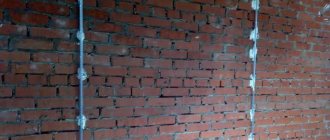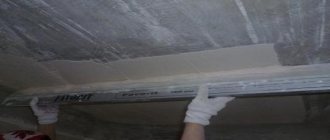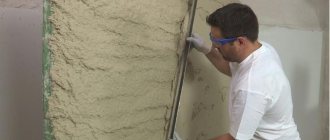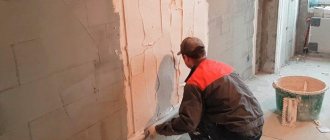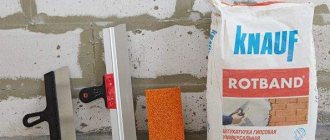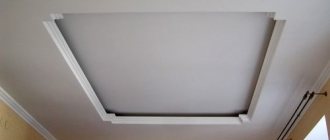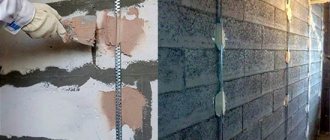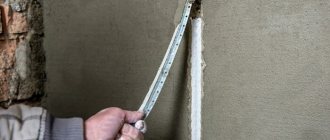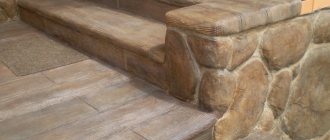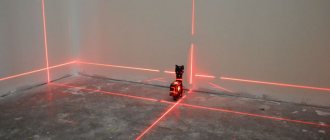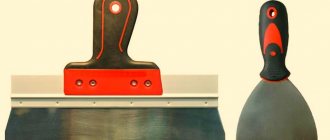Option 3: rubbed plaster beacons
If there are minor irregularities on the walls that need to be covered with a layer of plaster, builders refuse to work with galvanized iron lighthouse profiles.
Craftsmen prefer to install so-called rubbed plaster beacons. Manipulations require certain professional skills, the work time increases, but the result can please those who carry out construction or repairs themselves. If you need to build intermediate elements, two identical tools are attached to the walls, acting as the basis for creating a polished beacon
Materials and tools
Having chosen this technology, you should find out how to properly carry out the installation, what tools and materials will be required when the use of this method is justified. First of all, you will have to take care of having the necessary tools. The master will need:
- plumb line;
- rule;
- spatula;
- screwdriver;
- self-tapping screws;
- screwdriver;
- construction water level.
The prepared solution does not have a high level of strength, and the created structure will not be durable. It's better to prepare:
- Gypsum plaster (Rotband).
- Cold water.
When choosing a material intended to create a structure, it is important to remember that the dry mixture must contain gypsum. It is not allowed to use cement-sand mixture in the work.
The working process
The prepared, cleaned, primed wall is marked by marking on the surface the points into which self-tapping bolts will be screwed. It is to them that a plumb line is attached to determine the vertical line. It should be done at a distance of 5 cm on both sides of each inner corner.
You need to carefully select the rule used to create the rubbed beacon. Its size should not be 2-3 cm less than the height of the wall. The tool is fixed vertically using self-tapping screws, having previously drilled 3-5 holes in it, located at an equal distance. Further:
Use a level to mark the vertical. Fix the rule strictly along the red line, retreating 5 cm from the corner. Prepare a composition based on a gypsum mixture, mixing the ingredients well. Fill the gap between the wide edge of the tool and the inner corner with the prepared solution. After smoothing the edges, wait until the solution hardens, remove the screws and carefully remove the profile.
A water or laser level will help you check the correctness and accuracy of the actions performed. The main advantage of this method is that there is no need to remove the landmark before applying the plaster mixture to level the walls.
It is almost impossible to make any surface level without installing beacons. Knowledge and ability to carry out high-quality and accurate markings, determine the zero and working planes, install galvanized iron profiles or create plaster beacons will help you achieve success in achieving your goal.
Before you start work, you should carefully study all the positive and negative qualities of a particular design, choose the one that will save money and avoid additional time costs.
What about lighthouses?
We did the alignment using beacons, so a reasonable question is what to do with them? There is no clear answer. Some people use plastic ones, others use stainless steel ones. If everything is clear with the first ones (they do not rust, so if the wall is smooth, you can leave them), then what to do with the second ones, which can be easily scratched by the rule (and they can become rusty over time)?
Possible options:
- After about half an hour, remove the groove remaining after the lighthouse, carefully fill it with plaster mixture, level it and smooth it after an hour.
- If the wall is finished with tiles, then the beacons do not need to be removed and the wall does not need to be smoothed. Rust will not pass through the tiles. However, there are no problems with removing beacons. Therefore, it is better to remove them before the plaster solution has completely set.
Materials and tools
The necessary materials and equipment are purchased after figuring out how to properly install the beacons and choosing the method of attaching them, as well as the type of rail or profile. You will need:
- slats or profile for beacons, the length corresponds to the height of the wall. When the surface height is more than two meters, for convenience, sections 2 m long and additional sections up to full size are used. For example, for a room 2.5 m high, beacons 2 and 0.5 m long are used;
- cement-sand (cement-polymer) mortar for basic plastering work and the same mixture or quick-drying mortars (alabaster, cement-gypsum mixture);
- a primer to increase adhesion between the base wall and the plaster mortar and to slow the absorption of liquid into the wall. Especially relevant for red brick and foam or aerated concrete blocks, porous stone;
- water and a container for diluting the solution;
- level with a length of 2 m;
- rule length 1.3...1.5 m;
- trowels and graters;
- cord for aligning intermediate beacons (fishing line, thin flexible wire);
- electric drill and screws;
- protective equipment - glasses, gloves, respirator if necessary;
- chalk, markers, construction pencil or other means for marking the wall;
- brush (broom, vacuum cleaner) for initial cleaning of the wall.
Important: the control profile for plaster is available in lengths of 250...300 cm, widths of 10...20 mm and thicknesses of 6 and 10 mm. Moreover, the thicker and more rigid the profile used in the work, the more massive the layer of mortar can be applied to the wall
Thin profiles bend under the weight of the solution and the load from the rule when leveling.
Advantages and disadvantages
Like any type of work, leveling walls without beacons has its advantages and disadvantages. Specialists and ordinary craftsmen highlight the following advantages of this type of work:
- Economical use of the solution - when working with beacons you will need at least 7 millimeters of plaster, while without them from 4 to 6 mm, this allows you to save a significant portion of money and eliminates the need for a large amount of materials.
- Reducing the cost of repairs - a set of beacons for plastering walls will hit the budget hard, you will need additional tools and much more mortar, so working without beacons will help reduce the size of the budget for repairs.
- High quality plaster - thanks to the integral processing of the walls, the surface will be crack-free, because there will be no need to tear out the beacons: this process can damage the surface of the walls.
- Preserving the area of the room - a thinner layer of mortar allows you to preserve the volume and area of the room where the interior walls are being finished.
- Fewer materials - in addition to saving, the advantage is that there are fewer problems associated with additional work; screws and holders for beacons are not needed.
It should be understood that leveling walls using the beacon rule is much simpler than the plastering process, so if you have never plastered walls, it is better not to try to do it without beacons. The main disadvantage is the required work experience in this field, but there are other disadvantages:
- Minor defects - it is difficult to create a perfectly flat surface without beacons; you will need to additionally putty the walls.
- Drawing a plane - without experience, it will be problematic to draw diagonals and verticals; there will also be a lot of mortar on the floor during this process.
- Labor intensity - this type of work is more difficult than leveling walls with plaster according to beacons.
- It takes a long time - plastering without beacons cannot be done quickly.
Although installing beacons takes a lot of time, the process of leveling the walls is much faster with them, so work without beacons takes longer. The process will be complicated by the lack of a mixer, a good rule and a small number of spatulas of various sizes.
Types of lighthouses
Depending on the material and properties, the beacons differ from each other. They all have their own characteristics and specific application.
Metal
This is the most popular version of profiles available in construction stores. Installation of metal beacons is the simplest; no special training is required. They are most often not removed after work is completed. There are metal beacons of different sizes on sale, with small ones used infrequently, while medium and large ones are most in demand.
Perforated beacon profile
Since a thin profile is used for the manufacture of products, it can be easily cut with scissors according to the required dimensions, which is a definite advantage for the craftsman. The disadvantages of metal beacons include the risk of rusting. Such products are made from ordinary carbon steel, which is prone to corrosion. In some cases, this leads to the appearance of unsightly red spots on the finish. In addition, if the beacons are too flexible and thin, to fill them you will have to prepare a special solution to strengthen the structure, or additionally use clips.
Wooden
Such devices are made from rectangular wooden slats with a channel-shaped profile. After the plaster hardens, they are removed. It is necessary to saturate each lighthouse with a water-repellent agent in advance, otherwise the wood may warp and bend, and the coating will not be even.
Wooden guides for applying plaster
Plastic
Such profiles are made of durable plastic. Their standard thickness is 3, 6, 9 mm, length - 3 meters, although there are other options on sale. The advantages of plastic beacons are undeniable:
- light weight, easy to transport and store;
- strength is not lower than that of metal products;
- non-susceptibility to deformation, return to original shape after bending;
- no risk of corrosive destruction or rotting.
PVC profile for leveling
Plastic guides also have disadvantages. They are less resistant to shock loads than their metal counterparts. In addition, the products are not suitable for facade decoration, since they lose strength under the influence of sub-zero temperatures. They require strictly correct fixation on the surface, otherwise they will bend when moving the trowel.
Reusable steel
Beacons, which can be removed and reused after plastering, are an order of magnitude more expensive than disposable ones. They are made of very durable metal (usually stainless steel or galvanized), they will never move even when a thick layer of the mixture is applied. Due to the high price, such beacons are most often used by professional builders.
Reusable steel beacon with fastenings
Homemade
Craftsmen often use various homemade devices that act as guides. For example, when finishing wooden surfaces, wooden blocks of the required size are used, which are easily attached with self-tapping screws. Experienced finishers even make beacons from the mixture, applying it in “heaps” according to the level or on the heads of pre-screwed screws. There is no need to dismantle them, because they will be completely hidden by plaster.
Installation of self-tapping screws for leveling walls
Strings
These products are also homemade analogues of purchased beacons. To install them, screw in self-tapping screws and stretch a thin wire or string between them, checking the correct location with a level. The free space that has formed under the string is filled with plaster. The strings must be removed before the solution has completely hardened. If you make a mistake and install the string beacons incorrectly, you can end up with a crooked surface.
Set of string beacons for plaster
Laser
Such “beacons” are projected onto walls using levels or laser levels. Such devices create marking lines in one plane. If you install the device and set the vertical plane parallel to the position of the base, the laser beam on the floor will outline a line to adjust the thickness of the finishing layer. Using this mark, you can install self-tapping screws with a certain height.
Using a laser level to level the plane
How to attach a cable channel to a wall? 2 easy ways
It is no coincidence that any person who is not satisfied with the unaesthetic appearance of a wall or floor hung (covered) with twisted wires shows interest in how to attach a cable channel to a wall.
In addition, from the point of view of the likelihood of a fire, such harnesses are quite dangerous. Moreover, they can be mistaken for a toy by small children and pets. And stumbling or clinging to cords gets annoying. Of course, fixed wires are usually hidden in the wall during repairs. But if you, say, bought an air conditioner or gave your child a computer later, when the repairs have already been completed, it’s frankly a pity to ditch a freshly finished surface for the sake of one wire. This is where the electrical box comes to the rescue.
Its main advantages:
the ability to install everything yourself, insulation of wires from each other, acceptable appearance of the structure. Moreover, it can be fixed on any type of surface. Concrete, wood, foam block, even metal - everything is suitable.
How to attach a cable channel to a wall?
There are 2 main ways. Let's look at both in this article.
A box with a single section and a one-sided lid. Suitable if you need to stretch the cable from the entrance to the apartment to the TV or computer. Or to hide the cord from the air conditioner to the outlet.
Two-section box with double-sided lid. What you need if there are 2 cables going in the same direction.
If there are more wires, you will have to install additional cable channels on top of each other. However, in this case, you can already think about laying a groove - if the connection is stationary, and the owner does not intend to move the devices to which the cables lead.
Sometimes people are confused by the shape of the electrical box. It seems to them rude and does not fit into the interior. I would like to please you: the cable channel can have rounded, soft outlines. It will take a little longer to look for one, but it is not one of the scarce goods.
It is very simple to implement, but has a significant drawback: if necessary, the cable channel can only be removed with pieces of finishing or even plaster. In addition, if the walls are not very smooth, then uneven gaps will remain between the box and the surface, which is not very attractive visually and is not recommended for use. However, if you are sure that you will not have to dismantle the cable channel, you can use the following instructions.
- The cable channel is cut to size, applied to the wall, floor or ceiling, and compliance with the markings and tightness of joining of individual parts is checked.
- Glue (for example, liquid nails) is applied in a wavy line to the underside of the base of the segment. The width of the wave is approximately 1.5 times the width of the box.
- The element is pressed against the surface for a couple of seconds and immediately removed. The remaining adhesive trace on the wall should thicken a little.
- The channel returns to its place and is pressed, now more firmly, so that it grips the wall.
Often, to enhance reliability, the adhesive is supplemented with hammered nails or screws (depending on the wall material).
A special case of the adhesive installation method can be considered the installation of cable channels, on the base of which an adhesive composition has already been applied. However, this option usually does not inspire confidence among users, and therefore it is also supplemented with self-tapping fasteners.
A little more labor-intensive, but reliable and allows for dismantling. The upper part (cover) is removed from the cut cable channel. The base is applied to the marking and a hole in the wall is drilled directly through it. If the base is reinforced concrete, block or brick, it is easier to do this with a hammer drill.
Hole pitch – from 40 to 50 cm
. If the walls are clearly curvature, the distance is reduced so that the mounted box fits tightly to the surface along its entire length. The base is set aside, and the plastic part of the dowels is screwed into the holes. The lower half is put back and fixed with the main part of the fastener.
The wires are laid, the cover is put in place. And the question of how to attach the cable channel to the wall can be considered successfully resolved. You will have to decide for yourself which method you prefer. But advice: when choosing the adhesive method, at least occasionally add dowels to it, so as not to return to this again.
Installation
Let's look at the sequence of how to correctly place beacons under plaster.
1. In order to level the wall with plaster mortar and not overuse it, first you need to determine the section of the wall that protrudes as much as possible. This will be the starting point for installation.
2. Using a large level or a regular plumb line, you need to mark for installation. This step will be equally important both on walls that are simple in terms of geometry and on complex elements. Profiles can also be cut for installation at points of rotation or difference in height of the wall, and periodically they have to be bent when plastering rounded wall elements. Now on the market there are rules of various lengths, which already have a built-in level, which will greatly facilitate the implementation of horizontal markings.
According to construction standards, markings are carried out at a distance of 20 cm from corners and slopes, as well as on straight sections at a distance of 1.5-2 meters.
3
When choosing a method for installing beacons with your own hands, you need to take into account the physical and chemical properties of the material from which it is made. The leveling is carried out using a composition that will harden faster than the plaster mixture itself
For example, in the past, alabaster composition was used. Today you can use either gypsum-based glue or directly prepared gypsum initial plaster. During installation on such mixtures, you can easily adjust the level of the exposed element. To set it to the required level, it will be enough just to click on the beacon protruding beyond the required limits.
The most convenient way to install beacons under plaster is either with self-tapping screws or with fasteners that are now widely available. But this does not mean that the gypsum mixture is not suitable for this. On the contrary, for the most part, craftsmen place beacons on a gypsum mixture. For gypsum beacons, which some craftsmen also highly value for the speed of installation without additional devices, a gypsum mixture will probably be the only option for fixation.
Whatever composition you choose for fixing, it must be applied to the wall in small lumps. The most optimal distance between the fixation points is 30 cm. However, for the first in the row, it is advisable to make the interval between the clods 15-20 cm.
4
When installing beacons for plastering walls, it will be very important to maintain both vertical and horizontal levels. Also, during work, you need to ensure that the fixing solution covers the profile on both sides, and the existing perforation is carefully filled with the mixture
Providing reliable fixation will prevent it from moving during the application of plaster, during which significant loads will be created on profiles of any configuration.
When checking the level of the beacon immediately after its installation, while the solution is still damp, it is necessary to eliminate any deviations from the rule level - all gaps or sagging. When one edge of the profile deviates from the desired level, it must be adjusted by pressing or pulling out of the solution to fix it. If deviations from the level with a large length of the beacon are difficult to determine, then it would be best to install additional horizontal elements. Typically, such an operation is performed using a mechanized method of applying plaster, but in our case it can also be useful. Therefore, it is also recommended to understand how to place beacons under plaster walls using this method.
5. Designation of the required level for plaster using gypsum tape elements will have its own characteristics - it is prohibited to apply the plaster solution until the tape fastenings are completely dry.
As a visual example, here is a video on how to install beacons for plastering walls yourself without involving specialists.
We recommend reading:
- How to plaster walls with cement mortar;
- How to plaster a ceiling;
- What are flock plasters
https://youtube.com/watch?v=oJtjBHmaC1I
Technology of working with gypsum plaster
The beacon alignment technology comes down to the following. Step 1. Mark the wall using a level. Step 2 . We draw vertical lines at a distance of 0.8 meters. Step 3. Draw blots from the rotband along the lines. Step 4 . Now we install beacons on them. Their height is the thickness of our solution. Step 5 . We straighten them exactly to the level. Step 6 . We begin to throw the prepared solution onto the wall or apply it with a trowel. In this way, we process the distance between the beacons to a height of about a meter. Then we take the rule (in our case its length is approximately 1 meter 20 centimeters) and stretch out the plaster. Step 7 . We remove the excess mixture with a spatula and apply it either to the scratches or higher on the wall. For work at heights higher than your height, we use a small stepladder. Step 8 . Having aligned our wall in this way, we move to the next lighthouse. We work in the same way.
On a note. The plasticity of leveling with Rotband plays a cruel joke on us - the mixture can float after you start working with the next section of the wall. Don’t be alarmed, just re-smooth the surface using the rule, removing excess floated mortar.
Brief video instructions for Knauf Rotband gypsum plaster:
The process is completed if the finishing coating is tiles or decorative plaster. Leveling with Rotband will require additional steps if we paint or glue wallpaper.
After the plaster layer has set (after about an hour), it must be rubbed down. This is necessary in order to make the surface perfectly smooth. For grouting we use a more liquid solution. We will apply it with a stainless trowel with pressure, tearing off small tubercles.
If necessary, after one layer of grout has dried, you can repeat it.
How to set markup for beacons
Markings begin by determining the starting point, which is the most protruding part of the wall. In this part, the plaster layer will be made the thinnest, and the remaining places will be trimmed to match this area. You can mark with twine or a laser level.
In the first method, the top points in the corners of the wall are determined; they need to be placed at a distance of 10 centimeters from the corners and the ceiling covering. At the marks, a hole is made into which the self-tapping screws are screwed; it should not protrude too far from the outside by three to five centimeters. A plumb line should be attached to the screw, serving as an indicator of the vertical.
The same screwing in of self-tapping screws is done on the floor; their caps should be at the plumb level. These actions are done on both sides, a rope is pulled between the screws. Tensioning is also carried out along diagonal lines, resulting in a plane.
Next, they move on to drawing out the places where the first beacons will be attached. From the vertically stretched ropes they extend 10 centimeters, horizontal marks need to be placed in normal increments of 80-130 centimeters, in these places the following beacons will need to be fixed. If there is a door or window opening on the wall, 10 centimeters are also set back from it, a beacon should also be placed there.
To determine the most protruding place, using a ruler or tape measure, measure the distance from the wall to the rope, the measurements are recorded, the place with a small value will be protruding. As a standard, it is in this place that the first beacon is attached.
Markings begin by determining the starting point, which is the most protruding part of the wall.
Working with a laser level is easier and faster. A bubble level (2 m) is applied to the surface in different directions to determine the location of the most protruding point. Next we move on to determining the most protruding point vertically. This point can be marked with the level itself, or using a plumb line.
Having marked the extreme points from the wall, mark the intermediate ones; the step between them should not be greater than the length of the rule. The following steps will be performed depending on how you decide to install beacon profiles. And they will be described further.
Working with a laser level is easier and faster.
Top of the lighthouse
While our freshly baked lighthouse is drying, we can start making the neighboring one. The very next day (or at least a few hours later) you can start polishing the upper part. This is a little more difficult because working on a stepladder limits your movement and creates discomfort. One hand is constantly busy holding the beacon. There is one secret: “Rotband” perfectly holds the difficult rule and does not allow it to quickly slide down. Carry out an experiment: carefully release the rule - it should remain in place and only slide down a little. But don’t get carried away, otherwise he’ll definitely leave. Otherwise, the entire rubbing process is similar to that mentioned. To remove the beacon, let it slide down freely.
Methods for installing beacons
For plastering walls, floors or ceilings, the most widely used method is to install guides on gypsum mortar. In addition, special mounts are produced, named because of their appearance, for example, “Ushastik”.
Fastening using gypsum mixture
Before placing beacons under plaster, the surface to be treated is cleaned and primed. The height of the wall or the length of the floor and ceiling are marked. The beacon is cut to this size 1-2 centimeters smaller. This is done so that after finishing the work it can be easily removed.
Depending on the width of the rule - this is the tool with which the most even surface is achieved - the installation location of the slats is marked. The width between them is chosen so that it is 10–15 cm less than the width of the rule. The first guides are installed along the edges of the surface at a distance of 5–20 cm from the corner. When marking, the straightness of the marking lines is controlled: for this, a level or a construction suspension is used.
When installing beacons for plastering walls made of metal, a solution is prepared from a plaster mixture or gypsum. Next, after 30-40 cm, the prepared solution is applied to the marking line, to which the beacon is pressed. It is better to press the beacon using a level, as this will allow you to simultaneously fix and control the correct alignment of the staff. After installing the two outer beacons, a fishing line is stretched between them in several places. Using the fishing line as a height limiter, the remaining guides are installed behind it along the entire length of the surface. In the case of using beacons made of wood or plastic, similar actions are performed.
When using construction plaster, you need to remember that it sets quickly and allows you to quickly fix the beacons. But the time to adjust the position of the beacon does not exceed 3-4 minutes. If you use a cement-sand mortar, the setting time will be 6-8 hours.
Installation using “Ushastik” fasteners
Using Ushastik fasteners, the installation of beacon strips is greatly simplified. The device is at the same time an adjustment and holding device. The installation itself occurs according to the following steps:
- A hole with a diameter of 6 mm and a depth of 40-50 mm is drilled on the prepared surface, at a distance of 200 mm from the edge and 100-150 mm from the opposite surface. All other holes are made with the same dimensions. The pitch between dowels on a vertical line is 400 mm.
- A dowel is inserted into the hole and vertical markings are made. In this way, markings are made over the entire surface.
- Using a screwdriver or screwdriver, screws with Ushastik fasteners are screwed into the dowels. The depth of screwing is controlled by a level.
- The mounting rail is applied to the mount and crimped with an “Ushastik”. To perform crimping, round nose pliers are used.
Using this type of beacons, you can begin further finishing of the surface immediately after their installation. Their installation does not require special knowledge and experience.
After the beacons are installed, plaster mortar is poured between them so that it is above the level of the guides. Using the rule, relying on the beacons with progressive movements, excess solution is removed.
At the end of the work, the beacons can be left in the wall or on the ceiling, but it is better to remove them from the floor, since when screeding, these places will disrupt the solidity of the structure. The voids formed after removing the guides are filled with the same solution that was used to level the surface.
Making a lighthouse from Rotband
- We mix a couple of kilograms of “Rotband” (let’s take it as an example, although any other gypsum plaster will do). There is no need to immediately prepare a whole bucket of solution - you won’t have time to make it alone. First, knead a couple of kilograms, and then you will see the exact dose. If anything remains, smear it into the nearest gap between the bricks. Add a little less water than usual to get a thicker solution.
- It goes without saying that we thoroughly cleaned and primed the wall before doing this.
- Along the vertical line marked with a pencil, we begin to spread the mixture, trying to immediately give it the shape of a flat path (bed). At first it will be incredibly difficult; it requires experience and skill. We apply the mixture so that the height of the “bed” slightly overlaps the height of the screws.
- Using a spatula, we trim the path and add plaster in problem areas.
- Lightly moisten the wide end of the rule. There is no need to pour water, just wipe it with a damp cloth. This is necessary so that later you can easily remove the rule from the beacon.
- Now we apply the rule so that from below and from above it fits exactly on the heads of the screws and rests on them. The rule will press down the mixture; its excess must be carefully removed with a spatula. The most difficult thing in this matter is to keep the rule in one place so that it does not move or get off track. If you initially guessed the height of the lighthouse, then there will be enough plaster for the entire length of the rule and there will be no “dips” under it. If there are places that are not filled with the mixture, then it is better to remove the rule and add the missing volume. We set a rule so that the rubbed beacon is under the rule. You can clearly see how crooked our wall is, for example, mine; at the bottom the lighthouse stood almost at zero, and then it was already under 20 mm.
- Let's remove the rule. Very, very slowly we begin to move it up the lighthouse, without putting pressure on it or applying unnecessary force. At first, the metal will be difficult to move - it will seem to be “stuck” to the plaster. For this purpose, by the way, we moistened the end with water to facilitate sliding and separation of the rule from the lighthouse. About halfway through, we turn the rule so as to direct its movement upward and to the side. Gently remove it from the still plastic mixture, being careful not to damage the beacon. You can't describe this in words - you have to try it yourself.
- Removed. Let's look: if the surface of the lighthouse is smooth and without defects, then we take a step back and look with pride at the results of our work; if you need to add the mixture, then throw it on the problem areas and reapply the rule. And so on until complete enlightenment. But do not delay the process - the mixture will slowly “rise” and very soon it will be difficult to work with it.
Let's study the polished beacon after removing the rule. There will no doubt be some minor surface imperfections, but these are completely acceptable. We rubbed the lower part of the lighthouse. It is unlikely that you will be able to make the entire lighthouse at once the first time - to do this you need to rub about a hundred of them until you gain mastery and understanding of the essence of the process. This is the answer to the following question:
How the professionals do it
That's why they are pros, to do everything deftly and quickly. Pros don’t travel alone - they live and work in teams, where there is a clear division of labor. While one is busy with the beacons, the second is stirring up the next portion of the solution, and the third is washing the spatula or trough. That’s why they do everything quickly, smoothly, beautifully. You are the one holding the rule with one hand, and swearing with the other, removing excess solution. In the brigade, one holds, the other removes. And so on with everything else. But don't be upset. Sooner or later, your polished beacons will be no different from professional ones.
This is the result you should strive for - an absolutely flat surface, perfectly aligned to vertical zero.
How to draw a right angle between walls for subsequent installation of beacons
When marking and installing, it is important not only to make smooth walls, but also to create right angles between perpendicularly placed partitions. Unfortunately, these works are carried out extremely rarely, which is associated with a large overconsumption of plaster during repairs.
When doing the work yourself, we recommend that you determine the ideal geometry of each room; overhead costs will be small when using cement-sand or gypsum plaster.
Work on leveling corners is carried out in the following order:
choose the wall from which you will start: in rooms with windows, the outer wall of the apartment is taken as the basis, in interior rooms - the central wall, which you rest your gaze on when you enter the room;
subsequent actions depend on the condition of the main wall, if it has the shape of a “propeller” (various irregularities), the installation of embedded beacons begins and the wall is “pulled” into a flat vertical plane, then the rest of the room is marked;
to draw an angle (for a wall that is piled away from you), use a square or ceramic tile as a sample and the rule that is attached to the wall to determine the curvature of the angle - draw a line taking into account the embed. Do the same for all three walls;
to draw a corner (for a wall that is piled up on itself), markings are done along the ceiling with the help of an assistant, but this is a very labor-intensive task. In practice, leveling is carried out similarly to the version of a wall piled “away from you”, using a vertical level to determine the maximum “internal” angle of inclination of the wall. Then the right corners of the room are set similarly to the previous option.
Beacons for leveling walls: what are they?
Wall leveling is the process of creating a flat and smooth surface before applying a decorative layer. To smooth this layer, a long wooden or plastic board is used as a rule. To use it, beacons are installed on the wall plane, onto which plaster is applied. Thus, the beacons are rails for the movement of the rule and must withstand its pressure when removing excess solution. In addition to guiding functions, beacons also play the role of fittings.
Aligning walls with beacons
Today, beacons for leveling walls mostly mean perforated guides. Profile beacons are made of profiled metal or galvanized strip with perforation or plastic. They often remain in the wall after work is completed. The main requirement for the manufacturing material: chemical inertness. The beacon is in contact with wet cement or other mortar and therefore should not rust or react with aggressive substances dissolved in it. Otherwise, a yellow rust stain may appear on the wall and bleed through the finish.
Different beacon configurations
Modern beacons are designed for mounting on mortar, on self-tapping screws or on special polymer fasteners. Metal beacons can withstand quite large loads when applying the solution, leveling and removing excess without deformation. Plastic beacons are more often used on surfaces with complex configurations, when bending of guides along different radii of curvature is required. In addition, they are easier to cut in areas where the height of the walls changes.
Products vary in size. Standard sizes are 250 and 300 mm. This is exactly the length with which it is convenient for a master to work in a modern apartment. There are also longer beacons, the length of which reaches 6 m: such products are most often used for working in high industrial premises or for leveling floors.
Beacons 6 mm thick are used when the wall is flatter and it is necessary to apply a thin layer of mortar to level it. Six-millimeter paper is also suitable for cases when the beacon will be removed from the wall. Wider beacons - 10 mm - have greater rigidity and are installed when the wall is obviously very uneven. They are also used when pouring floor screed. A metal thickness of 6 to 10 mm provides the necessary rigidity when layers of plaster of different thicknesses are applied. The presence of perforations on the product provides better adhesion to the solution and fastening to the surface.
6 and 10 mm beacons
Beacons are classified according to their design features:
- V-shaped - used directly as guides for the rule;
- corner (L and T-shaped) - for decorating corners.
Installation of beacons for plaster
Professional plasterers still use mortar beacons made of plaster to level walls. They are made quickly, do not require additional costs and do not require dismantling. However, to do them quickly and correctly requires considerable professional experience. In addition, mortar beacons do not meet the requirements of rigidity and do not always withstand the rule pressure exerted when leveling the surface.
You can use improvised materials such as pieces of square metal profiles or pipes to create guides. Such guides must be cut out of the wall one day after completion of work on the walls, and then the groove must be sealed. Wooden blocks for creating lighthouses are practically not used today due to warping and deformation that occurs as a result of the influence of water on them, which is always present in the solution.
To install guide beacons, special fasteners have been developed that allow you to adjust their distance from the wall. There are several types of fasteners: these are umka, eared, and cremmers. Ushastik, for example, looks like a plate with side clamps with ears. It costs a penny. Using such an adjustment and retention system, beacons can be quickly installed.
Crammer fasteners
Beacons for cracked walls: types of devices and methods of using them
Cracks that appear on the walls of a building not only spoil the aesthetics of the building, but are also a sign of serious architectural problems.
If such a situation arises, be sure to notify the company responsible for operating the structure.
Specialists must conduct a technical assessment of the structure, establish the degree of safety for further use and approve a list of measures to eliminate the problem.
READ ON THE TOPIC: How to repair cracks in concrete: causes of appearance and solutions
During the inspection, the age of the damage is taken into account. Beacons are also installed on wall cracks to determine the dynamics of destruction.
Rules for plastering lighthouses
Before figuring out how to place beacons under plaster, it is important to clarify the order of work in general
Preparing the wall
The illustration shows a typical example of a wall that requires leveling.
If there are old finishing materials or remnants of plaster on the surface, they must be removed before taking measurements and the wall must be thoroughly cleaned of dust, dirt and debris.
Before installing beacons, it is necessary to check the verticality of the wall, the correctness of the angles (the angle between adjacent walls should be 90 degrees over the entire height of the room), and the presence of noticeable protrusions. The first point is checked by a level or plumb line. For more effective measurements, it is advisable to use a laser level, but with some handling skill, a bubble level with a length of 2...2.5 m or a plumb line of the same length is acceptable. The correctness of the angles is assessed using a square or laser level.
The presence of significant irregularities (depressions, protrusions) is determined visually. If this is difficult, you can check it after installing the basic (corner) beacons.
Surface primer
Treating the wall with a primer with antibacterial, fungicidal and adhesive properties is necessary. It is advisable to do this before installing the beacons. The more porous the wall surface, the more carefully you should consider the choice of soil.
Base marks
Installation of beacons for plastering walls begins from the corners of the room. The base slats are fixed at a distance of 15...30 cm from the corners on both sides of the wall.
To simplify the creation of a strictly vertical line of a profile or rail, experts advise creating a “line” of self-tapping screws. For this purpose, holes are drilled in the wall along the entire length of the future lighthouse, and self-tapping screws (screws) are attached to dowels (wooden chips) so that the cap does not adhere to the wall. A plumb line is hung on the top self-tapping screw, and the heads of the intermediate and bottom screws are aligned with it. The same procedure can be performed using a level. For metal profiles, the same self-tapping screws can be used to install beacon fasteners. The distance between fasteners is assumed to be 25…40 cm.
Next, the rail (profile) is mounted.
Another option for installing beacons for plaster is on the solution. Using a plumb line (level), a vertical line is drawn on the wall. Along this line, at intervals of 15...30 cm, a mortar is thrown with a trowel, to which the beacon is applied. By pressing down the beacon with a level and maintaining its strict verticality, a stable position of the slats (profile) is achieved.
Important: if the wall is “filled up” both to the floor and to the ceiling, the minimum distance between the lighthouse and the wall may be at the middle of the height or in any other place. Therefore, before starting work on installing beacons with your own hands, it is important to find the deepest and most protruding place on both lines of the base (angular) marks.
How to install beacons on a crack in a wall
To achieve the ideal condition of the walls after facing work, it is necessary to first prepare and level them very well. The best way to level walls is to use beacons. This process is quite simple, but has a large number of nuances, without knowledge of which it is impossible to produce high-quality alignment. In this article we look at leveling walls using beacons: we learn how to place beacons under plaster with our own hands.
The best way to level walls is to use beacons
Preliminary surface preparation
In order for the leveling of walls using plastering to be of the highest quality, it is necessary to completely remove the old layer of plaster to the very base. If you do not want to do this, then you need to conduct a thorough inspection of the surface of the walls in order to identify obvious defects or areas where there are significant irregularities or the plaster is falling off. In such places it is necessary to remove the old coating.
First of all, you need to very carefully examine all surfaces of the walls. If there are deep depressions, they need to be covered with a layer of plaster. All depressions must be level with the rest of the surface; height differences can only range from 5 to 12 mm. Small protrusions need to be cut off with an ax.
You shouldn't trust your eyes; it's better to use a laser level or regular thread. You need to screw screws into the walls near the ceiling on both sides and attach plumb lines to them all the way to the floor. Between them it is necessary to stretch a horizontal thread, at the ends of which there are sliding knots.
It will need to be moved from top to bottom along the entire wall, marking problem areas with a pencil.
Carrying out preliminary work
After all the rough work of preparing the walls is completed, you need to carefully sweep the wall from dust and dirt using a broom or vacuum cleaner. After this, it is treated with a primer, which protects the surface from excess moisture absorption. In addition, it will prevent the appearance of fungus and mold. The selection of the primer mixture is carried out depending on what material was used to build the wall.
Sometimes it is necessary to use a reinforcing mesh under plastering, especially in the kitchen or bathroom, since ceramic tiles will be glued there. This need also arises when there is a layer of plaster of more than 10 mm. The reinforcing mesh is attached with dowels or directly onto the mortar.
